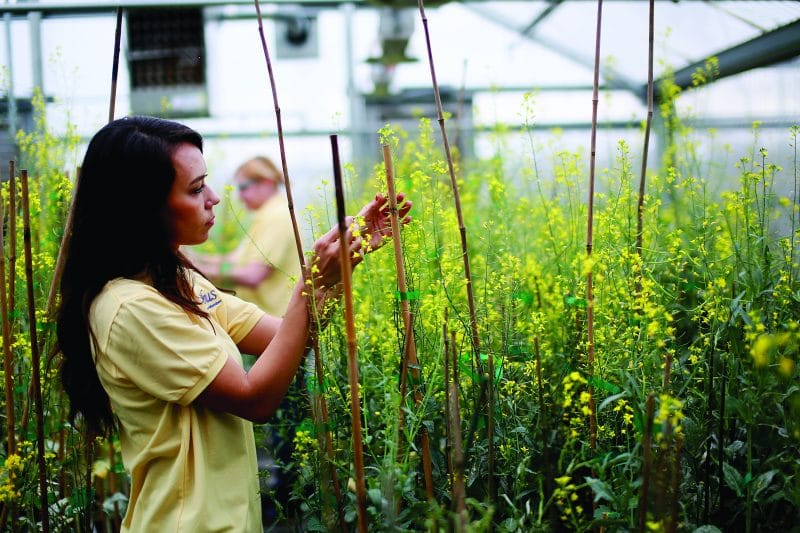Cibus shares its thoughts on innovation in the world of plant breeding
European Seed dives once again into the exciting world of plant breeding innovation. In previous articles we have written about many of the new methods themselves and contemplated the political implications. Now the floor is given to the actual users of the methods. To this end, European Seed sat down with Greg Gocal, chief scientific officer for Cibus.
EUROPEAN SEED (ES): What kind of company is Cibus, and what kind of crops are you working in?
GG: Cibus recently celebrated its 15th anniversary and now has over 100 employees in Europe and North America, with the majority working out of a state-of-the-art research and development centre in San Diego, California. We use a variety of new and traditional techniques to develop improved crop varieties with characteristics that help address the challenges farmers and the industry are facing today and will face in the years to come. The possibilities are endless and our current activities include improved tolerance to diseases, herbicides and environmental stresses, improved yield and crop quality.
Over the next decade or so we are aiming to develop products for all major crops. Our more advanced project crops include rapeseed, rice, potato and flax or linseed. We work closely with seed companies around the world and in the United States we are selling canola hybrids from our own breeding program.

ES: Cibus is at the forefront of the development of new plant varieties, based on some of the so-called new breeding methods. Why did Cibus go for these techniques?
GG: Our ultimate goal is to develop new plant varieties with characteristics that can make a real difference for farmers, the food and feed industry, the environment and the consumer. We use a range of non-transgenic techniques and some of these are described as new breeding methods.
We are perhaps best known for a method known as oligonucleotide-directed mutagenesis or ODM. Although ODM is classed as a new breeding method, it actually dates back over 20 years to the mid-1990s when it was first evaluated for human health applications like sickle cell anemia. Cibus scientists were involved in plant applications of ODM from the outset and quickly recognized the potential. Of all the new methods available to breeders, ODM is perhaps the most remarkable in that it can be used to guide a plant cell to make a precise change to the code of its own DNA. The change is exact — one letter (a nucleotide) in the DNA code is swapped for another specified letter at an exact location within a specific gene in the plant genome. No foreign DNA is introduced, there are no other changes to the genome and the targeted change is indistinguishable from changes arising naturally or induced by other forms of mutagenesis.
The technique relies on a family of DNA repair enzymes that have evolved in plant cells specifically to correct any mistakes made when the plant’s DNA is copied preceding cell division. A copying mistake is apparent when the complementary strands of the DNA don’t match. If the DNA repair enzymes identify a mismatch, they remove the mismatching nucleotide and replace it with a matching nucleotide. ODM works by simulating a specific mismatch at a precise position within a target gene. When the mismatch is identified, the DNA repair enzymes correct the mismatch in exactly the same way they would correct a normal copying mistake.
Cibus has developed an advanced non-transgenic breeding system called the Rapid Trait Development System (RTDS™). This system combines enhanced cell biology, precision gene editing and innovative molecular screening to deliver new crop characteristics faster and more efficiently than was previously possible.
ES: How do you know which changes in the DNA code will lead to improved crop characteristics?
GG: The short answer is that more often than not, our inspiration comes from nature. Even within the same species we can see a remarkable diversity of characteristics, and thanks to genomic sequencing we have an insight into the associated genetic diversity that drives this. Intriguingly, genomics is also helping us to see how the same gene has changed as closely related species evolve independently. Increasingly powerful bioinformatics is helping us link phenotype and genotype and identify the single nucleotide polymorphisms (SNPs) and combinations of SNPs that enhance or add plant characteristics that would benefit crop plants
ES: This is a very active area of science. How do you see developments in the crop sector?
GG: The huge potential for human health benefits of genomics and gene editing are in the news almost every day, but these developments have made it an incredibly exciting time to be a plant biologist, too. More than 100 plant genomes have now been sequenced, there are reference genomes available for most major crops, and several crops have sequence data for hundreds and sometimes thousands of different lines. As a result of all this work, massive amounts of genomics data are now available to feed into ever-more powerful bioinformatics tools. At the same time, we’re experiencing amazing developments in gene-editing technologies whereby gene function can be investigated more readily than ever before.
The knowledge base in this area has expanded at a rate that was just a dream a few years ago. The sheer volume and quality of genomics data is unprecedented and the accessibility of gene-editing tools is inspiring a new wave of research by scientists in small and mid-sized companies and in academic laboratories around the world. As a result, there has been an explosion in the volume of research and the number of publications connecting gene sequence and function to phenotypic characteristics. Out of this work we are seeing an increasing number of characteristics that could have significant benefits for crop production.
New breeding methods like ODM have the potential to enable this incredible research to become a practical reality by delivering new crop characteristics that can make a difference, and that’s a huge motivation for companies like Cibus.
ES: What kind of beneficial characteristics are being identified in this way and how confident are you that the research will translate into real benefits in crops?
GG: The range of characteristics identified is already huge and covers almost every aspect of crop production from yield and quality characteristics through to the ability of plants to tolerate pests, diseases, herbicides and a wide range of environmental stresses.
The first products of new breeding methods (improved crop quality and improved tolerance to herbicides) are already available, but these represent only a small proportion of the total potential. For an alternative perspective we can look back at the achievements of older forms of mutagenesis. Long before gene sequencing, plant breeders used chemical or irradiation mutagenesis techniques to introduce diversity into breeding programs. The technique introduced multiple random mutations into the genome of a selected variety and the task of identifying the beneficial characteristics was extremely laborious.
It is a testimony to the skill and hard work of the breeders that so many remarkable new characteristics were identified. Their diligence led to consumer favourites like seedless citrus and ruby red grapefruit, coloured peppers and major advances in quality characteristics in crops like malting barley and durum wheat. Less familiar for consumers but equally encouraging are the varieties with improved tolerance to a wide range of pests and diseases, earlier maturity, resistance to lodging and improved tolerance to environmental stresses like to drought, heat and salinity.
With the older forms of mutagenesis, the improved crop characteristics were achieved by chance, they came with multiple unwanted mutations and they were almost impossible to replicate in another variety or another crop. In fact, some beneficial mutations only occurred once in more than 100 years. Once the target mutations are identified, new breeding methods like ODM can introduce the same characteristics, without chance, into multiple crops or varieties and with no unwanted mutations.
ES: What can the industry do to realise the potential of these technological advances?
GG: The success of new breeding methods depends not only on the breeding methods themselves, but also on the associated technologies of genomics and bioinformatics and the research efforts that link all of this together. At present, scientists in academic and commercial laboratories worldwide are making incredible progress in all areas. It is clear that the companies, charities and governments funding the work recognize that the potential benefits for crop production are very significant. In order to realise the true potential of these technological advances, the organisations responsible for the development and commercialization need to be confident that the improved varieties can be introduced into the market and traded internationally. This has been recognized for some time by regulatory authorities and industry associations. The European Seed Association and the International Seed Federation have made clear the need for regulatory clarity and consistency worldwide.
ES: How do you see the use of the new breeding methods developing in both your company and in the industry as a whole?
GG: Like many other developments that have gone before, new breeding methods represent an additional toolkit with the potential to greatly accelerate the breeding process.
The database connecting important crop characteristics to SNPs and gene knock-outs is growing steadily. Whilst it is possible for exactly the same SNPs or gene knock-outs to occur at random, the chances of them being found in breeding lines of a crop of interest are extremely remote.
New breeding methods provide an opportunity to introduce these specific changes to elite crop lines within a few years or even months depending on the crop, the changes required and the methods employed.
New breeding methods like ODM, in combination with genomics and bioinformatics, have the potential to accelerate plant breeding at an unprecedented rate and make a major contribution to food security in an increasingly challenging environment.













